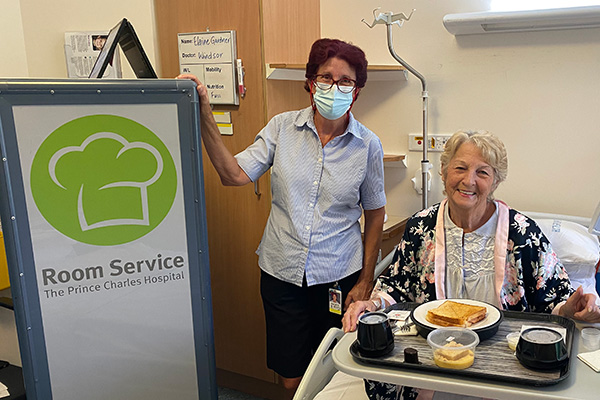Room service model research highlights patient and hospital benefits
A research study into an innovative patient-centred model of meal delivery implemented at The Prince Charles Hospital (TPCH) has shown positive results for improved patient nutrition, reduced food costs, and increased patient satisfaction.
The new room service model implemented at TPCH in May 2019 was a Queensland Health hospital-first, and provides patients with greater flexibility and meal choice.
Under the room service model, patients can order their meals from an improved menu offering an expanded range of food items such as burgers, toasted sandwiches and stir-fries, at a time of their choice. This gives patients the ability to order their meals based on their appetite, and around clinical tests and procedures, increasing the likelihood that patients will complete their meals.
The change in model was initiated by the Food Services Department‘s dietitian team leader. It came as a result of staff continually observing large amounts of plate waste from unfinished meals ordered from the previous food service model which was based on a less varied menu and fixed meal delivery schedule.
The research study compared various factors between the previous bought-in reheated food service and a cooked to order room service model at TPCH including nutritional intake, waste, patient satisfaction, meal costs and meal quality.

Patient Elaine Gardner receives her meal from Room Service attendant Cheryl Dwyer
Room Service Project lead, Bianca Neaves said the previous model provided limited flexibility around when patients could have their meal delivered, meaning that patients undergoing tests or procedures at the time of meal delivery would often return to a cold meal. This resulted in patients eating less and, therefore, not getting the energy intake and nutrition needed for their recovery.
“It also meant more plate waste and more production waste due to uneaten meals, resulting in increased food waste and costs,” Bianca said.
Through regular audits conducted by TPCH Food Services staff, before and after the implementation of the new room service model, it was found that the new room service model resulted in significant improvements across all factors investigated in the study when compared with the previous model.
Patient plate waste was reduced significantly from 40 per cent to 15 per cent, indicating higher levels of meal consumption among patients.
“This result told us that patients were eating more, getting the energy and nutrition they needed to get home sooner,” Bianca said.
As the first study in Australia to measure production waste in a room service model, TPCH’s research also highlighted a 10 per cent reduction in production waste, as well as a 9 per cent decrease in overall food costs.
“Our research showed that the introduction of a room service model at TPCH has resulted in a significantly improved meal service that is patient-centred as well as hospital-centred,” Bianca said.
“The room service model demonstrates that patients eat more, is more efficient, costs less and patients prefer it. It ticks all the boxes for a contemporary meal delivery model at a large tertiary hospital like TPCH.”
The success of the room service model at TPCH has influenced the introduction of the model at other Metro North hospitals including Caboolture Hospital and the Surgical, Treatment and Rehabilitation Service.
Aspects of this work was guided through completing the Graduate Certificate in Health Services Innovation.
